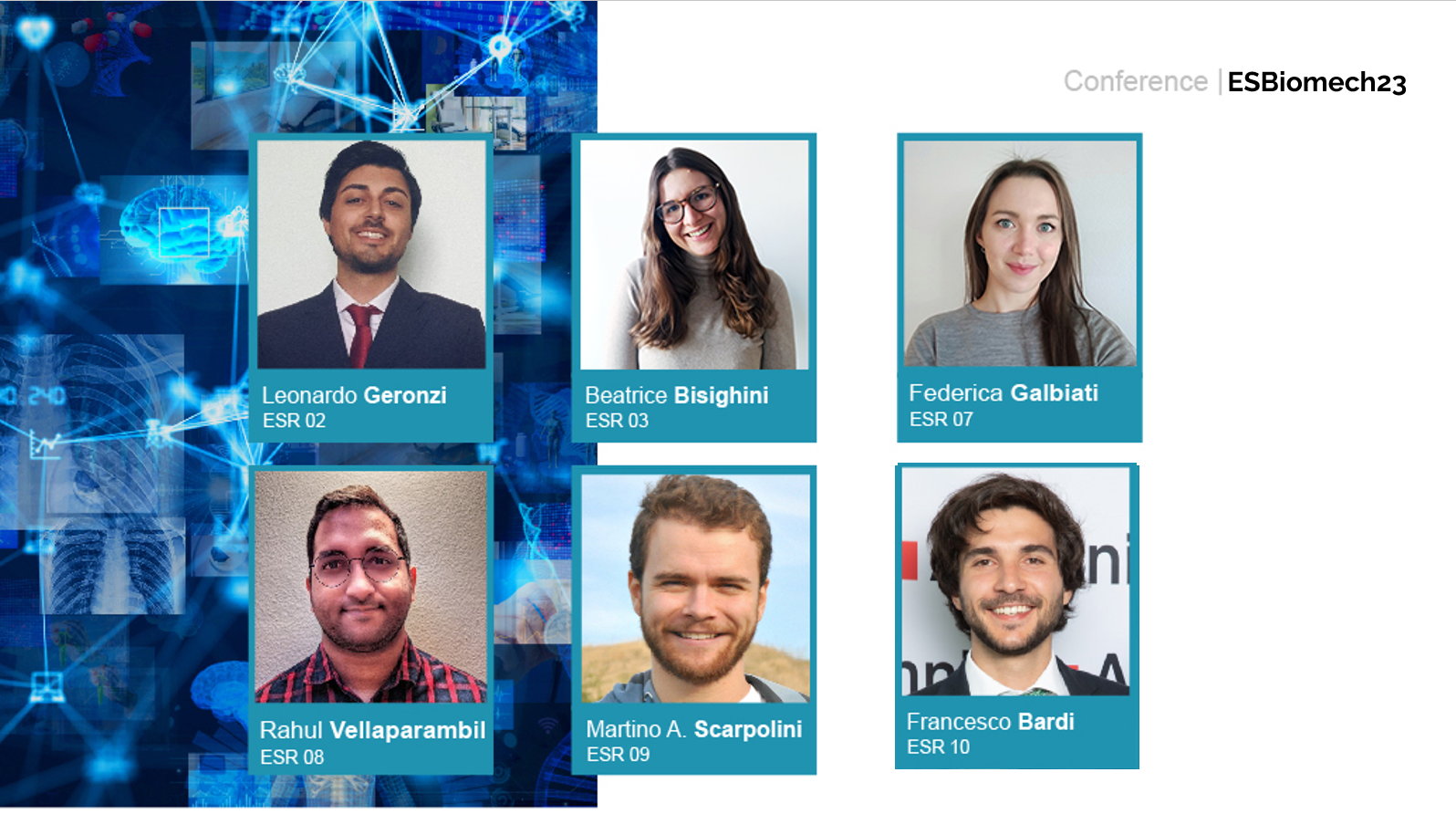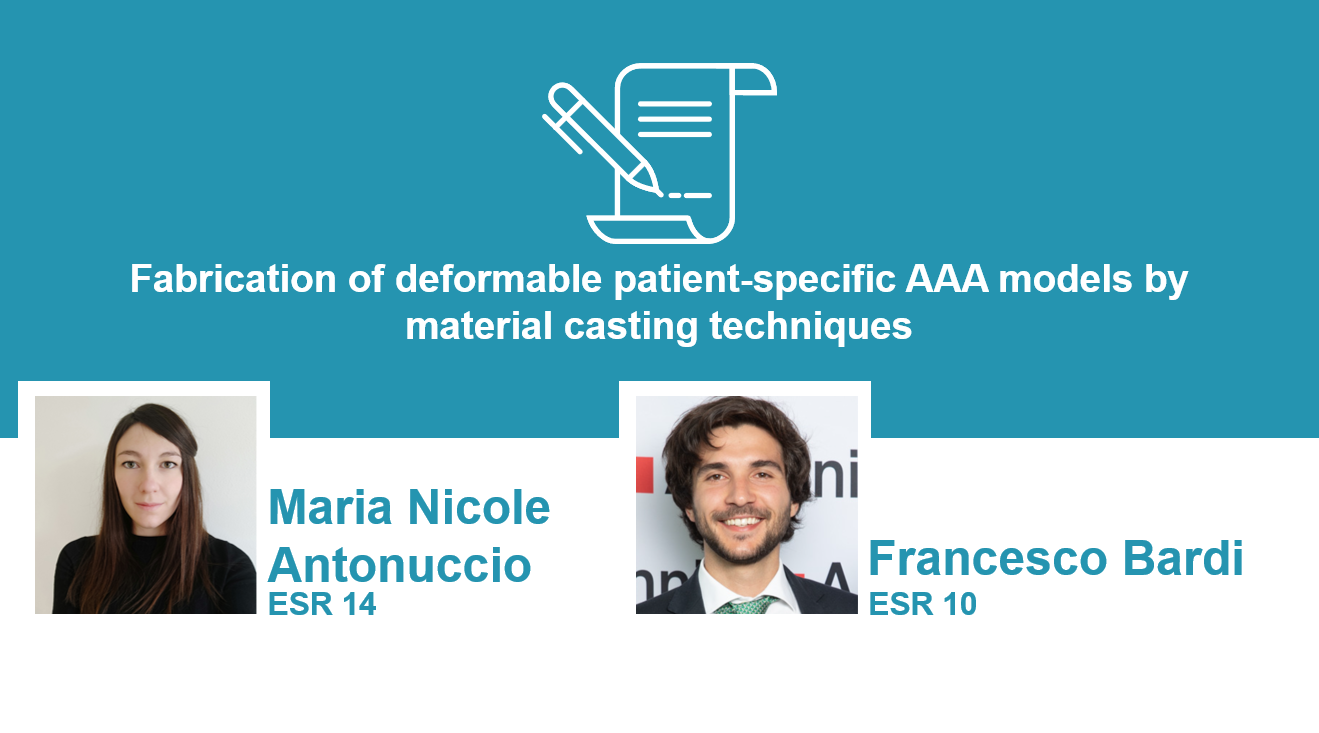The MeDiTATe project at the X International Conference on Computational Bioengineering (ICCB 2023)

The MeDiTATe project will be present at the ICCB 2023. The event will be held on the 20 – 22 September 2023 in Vienna (Austria) and will be hosted by the Institute for Mechanics of Materials and Structures of Technische Universität Wien (TU Wien).
In this occasion Marta Bracco, ESR 13 of the MeDiTATe project will present the results of her activities with a presentation whose title is “A simple approach for ultrasound-based AAA stiffness estimation including the effects of surrounding tissues and probe pressure”.
An abstract describing the work is reported hereinafter: “Clinical decision making for abdominal aortic aneurysm (AAA) treatment is based on the measurement of the maximum diameter from medical images (Wanhainen et al., 2019). However, the diameter alone has shown a limited ability to correctly predict the risk of rupture, which in turn can negatively affect the patient’s survival rate (Vorp, 2007). Biomechanics-based indexes have proven better predictive ability, but they have not yet found practical application in clinical context (Polzer et al., 2020). In vivo non-invasive estimations of AAA tissue properties can help to achieve clinical translation. Methods based on time-resolved ultrasound (US) were proposed, being ultrasound the most commonly employed imaging technique for AAA monitoring (Van Disseldorp et al., 2016) and should take into account the effect of surrounding tissues (Petterson et al., 2019). It was also noticed that US scanning procedure itself introduces an external force applied to the AAA via the transducer push, causing deformations in the aortic wall (Ghulam et al., 2022). In this work, we propose to correct the AAA material properties estimation by means of a multi-factorial correction coefficient, taking into account the geometry, the surrounding tissues and the probe pressure thanks to finite element modelling. Three patient specific geometries of AAA and surrounding tissues were obtained from clinical images via segmentation. Specifically, the soft tissues surrounding the spine up to the patient surface were simplified as a homogeneous material. The spine geometry was subtracted from the soft tissues and it was modelled as a boundary condition, fixating the internal surface created by the cut. Through this approach, both the effect of the hard and soft surrounding tissues was considered. The AAA wall was modelled as orthotropic linear elastic material as in Perrin et al., 2015, while the surrounding tissues were modelled as hyperelastic neo-hookean materials as in Petterson et al., 2019, and the value of shear stress was obtained by calibrating the simulation according to the data presented in Ghulam et al., 2022. The inner wall of the AAA was subjected to patient-specific blood pressure and the outer wall was tied to the surrounding tissues. We also applied a localized uniform firm pressure of 13.85 kPa (value from Ghulam et al., 2022) on the outer surface of the patient in the antero-posterior direction. The stiffness of the AAA wall was then calculated as the ratio between the hoop stress, calculated with the Laplace relationship, and the hoop strain. The effect of geometry was quantified by comparing the results for the pressurized patient specific AAA geometry to an idealized case, i.e. a pressurized thin walled cylinder, obtaining the first correction factor μ𝐺. Progressively adding complexity, we obtained two more correction factors μ𝑆𝑇 and μ𝑃𝑃 respectively correcting for the presence of surrounding tissues and probe pressure. We found the correction factors to be consistent across patients: μ𝐺= 0.70 (0.042),μ𝑆𝑇=2.01 (0.002), μ𝑃𝑃=1.14 (0.025). μ𝐺= 0.70 (0.042), μ𝑆𝑇=2.01 (0.002), μ𝑃𝑃=1.14 (0.025). We conclude that the presented method is a promising and simple approach to account for the different factors affecting US-based biomechanical estimations.”.
A new MeDiTATe project publication: “Enabling supra-aortic vessels inclusion in statistical shape models of the aorta: a novel non-rigid registration method”

A new paper “Enabling supra-aortic vessels inclusion in statistical shape models of the aorta: a novel non-rigid registration method” has been published in the Frontiers in Physiology Journal. The paper was written by Martino Andrea Scarpolini ESR 09 as well as by Dr Simona Celi Ethic Coordinator of the MeDiTATe project.
The full paper is available at this link.
MeDiTATe Newsletter #3 – July 2023

The third MeDiTATe project newsletter is out! It contains main news, latest events and much more of the activities carried out in the second trimester of the 2023.
The newsletter can be downloaded at the following link: MeDiTATe Newsletter #3 July 2023.
A new MeDiTATe project publication: “Prediction of guidewire-induced aortic deformations during EVAR: a finite element and in vitro study”

A new paper “Prediction of guidewire-induced aortic deformations during EVAR: a finite element and in vitro study” has been published in the Frontiers in Physiology Journal. The paper was written by Monica Emendi ESR 11 of the MeDiTATe project.
The abstract is as follows:
Pre-operative planning and intra-operative navigation of endovascular aneurysm repair (EVAR) are currently challenged by guidewire-induced deformations. In this work we aim to predict the above-mentioned deformations by means of a validated finite element approach. Hence, three physical patient-specific models of increasing anatomical complexity, i.e., including the intraluminal thrombus (ILT) and calcifications, were manufactured. The numerical and experimental results were compared. A good agreement was found between the experimental and the computational studies, characterized by an increasing trend in deformations from a simplified model to a complete model (with ILT and calcifications). The presented computational approach, used in combination with tracking technology, can potentially display a continuously updated 3D anatomical map to the operator during EVAR, limiting the use of X-ray and contrast agent.
The full paper is available at this link.
Last week the MeDiTATe project was at the ESBiomech23









The MeDiTATe project was present at the 28th Congress of the European Society of Biomechanics (ESBiomech23). The event took place in Maastricht, The Netherlands from 9 to 12 July 2023.
In this occasion six of the Early-Stage Researchers (ESRs) presented the results of their activities with both oral and poster presentations: Leonardo Geronzi – ESR 02, Beatrice Bisighini – ESR 03, Federica Galbiati – ESR 07, Rahul Vellaparambil – ESR08, Martino Andrea Scarpolini – ESR 09, Francesco Bardi – ESR 10.
A new MeDiTATe project publication: “Computer-aided shape features extraction and regression models for predicting the ascending aortic aneurysm growth rate”

A new paper “Computer-aided shape features extraction and regression models for predicting the ascending aortic aneurysm growth rate” has been published in the Computers in Biology and Medicine Journal. The paper was written by Leonardo Geronzi (ESR 02) as well as by other including Marco Evangelos Biancolini, Principal Investigator of the MeDiTATe project.
The abstract is as follows:
Ascending aortic aneurysm growth prediction is still challenging in clinics. In this work, a method to exploit local and global shape features for the prediction of the ascending aortic aneurysm growth rate is presented. By using a framework based on geometric decomposition, mesh morphing, statistical shape analysis and regression methods, we were able to extract local and global shape features potentially valuable for improving the prediction of the aneurysm growth. The results of this study show that aneurysms close to the root with a large initial diameter report faster growth.
The full paper is available at this link.
A new MeDiTATe project publication: “Patient-specific computational modelling of endovascular treatment for intracranial aneurysms”

A new paper “Patient-specific computational modelling of endovascular treatment for intracranial aneurysms” has been published in the Brain Multiphysics Journal. The paper was written by Beatrice Bisighini (ESR 03) as well as by other authors ìincluding Stéphane Avril, Research Coordinator of MeDiTATe project and PhD Supervisor of Beatrice Bisighini.
Here some highlights from the paper:
- State-of-the-art analysis of numerical modelling of the endovascular treatment of cerebral aneurysms, emphasizing the accuracy and efficiency aspects of the different techniques present in literature.
- Evaluation of how these scientific tools and discoveries can assist practitioners in the pre and intraoperative stages predicting the intervention outcomes.
- Discussion of challenges related to endovascular treatment modelling that require further study.
The full paper is available at this link.
The MeDiTATe project at the 28th Congress of the European Society of Biomechanics (ESBiomech23)

The MeDiTATe project will be present at the 28th Congress of the European Society of Biomechanics (ESBiomech23). The event will be held in Maastricht, The Netherlands July 9 -12, 2023.
In this occasion six of the Early-Stage Researchers (ESRs) will be presenting the results of their activities with both oral and poster presentations:
Leonardo Geronzi – ESR 02:
- ASCENDING AORTIC ANEURYSM GROWTH PREDICTION BASED ON MACHINE LEARNING AND SHAPE FEATURES DERIVED FROM 3D SLICER
The evaluation of a pathological ascending aorta is challenging due to its morphological variabilities, which cannot be adequately assessed by measuring the diameter alone. Additional measurements derived from a 3D model are necessary to accurately evaluate the condition. Computational biomarkers have already demonstrated their significance in diagnosing cardiovascular diseases. In this study, we used longitudinal data to observe the progression of the aneurysm over time. By decomposing the geometry of the ascending tract of the aorta in 3D Slicer, we extracted a set of local and global shape features. Machine learning classification and regression models are then employed and compared to predict the risk associated with the disease.
- DEVELOPMENT OF DIGITAL TWINS FROM HIGH-FIDELITY SIMULATIONS FOR HEALTHCARE APPLICATIONS
The approach of using in-silico models based on computer-aided engineering (CAE) to study diseases, suggest treatment strategies and predict surgical outcomes proved to be crucial in supporting the clinical staff. However, the high numerical complexity and computational cost still represent a challenge with respect to the exploitation of such results. To overcome these limitations, new methods based on medical Digital Twins (DTs) are under development. DTs are virtual replicas of physical systems able to digitally replicate their behaviors providing a connection between the physical entities and the corresponding digital models. In this work, we describe the techniques we use to build medical DTs and their application to two clinical cases: the drug-delivery simulation of the airway system and the determination of the effect of an exertion activity on the ascending aortic aneurysm.
Beatrice Bisighini – ESR 03:
- MACHINE LEARNING-BASED REDUCED ORDER MODELLING FOR THE SIMULATION OF BRAIDED STENT DEPLOYMENT
This work presents a machine learning-based reduced-order model scheme, trained on finite element simulations, to compute the deployed configuration of flow diverters within patient-specific models in real-time. Flow diverters are very dense braided stents used in the endovascular treatment of cerebral aneurysms. Computational tools could be useful in assisting surgeons in the selection of the best device for a patient, especially in complex cases. However, due to the large amount of degrees of freedom and the necessity to solve the contact with the wall, the computational time required by traditional techniques alone, such as finite element modelling, is excessively high. Machine learning-based reduced order modelling can enable real-time prediction while retaining the mechanical realism and predictability of the stent deployed configuration.
Federica Galbiati – ESR 07:
- ASSESSMENT OF THE COMBINED EFFECTS OF VALVE PHENOTYPE AND ANEURYSM PROGRESSION ON ATAA HEMODYNAMICS
The presence of a bicuspid aortic valve (BAV), with consequent eccentricity of aortic inlet flow, gives rise to altered aortic hemodynamics. This seems to play a role in the highest prevalence of ascending thoracic aortic aneurysm (aTAA) in BAV patients, compared to subjects with tricuspid aortic valve (TAV). Characteristics of aortic hemodynamics in presence of eccentric inlet flow in both healthy and aneurysmatic aorta have been widely addressed, while perspective studies that investigate the evolution of hemodynamic patterns concurrently with aTAA progression are still limited. Therefore, the main goal of this study is to assess the role of both TAV and eccentric BAV inflow on hemodynamic results at different stages of aTAA, coupled with the development of a parametrized time-space-varying inflow model to reproduce patient-specific TAV / BAV aortic inlet condition.
- AORTIC HEMODYNAMICS EVALUATION BASED ON REDUCED ORDER MODELS: EFFECT OF INLET CONDITIONS
Computational fluid dynamics assessment of patient-specific hemodynamics using full order models is a viable tool to gain insights for pathology evaluation, treatment, and prevention. However, its use in clinical practice is hindered by its high computational cost in terms of infrastructures and timing. Moreover, these limitations are reflected in the difficulties to be directly translated to clinicians. In this context, nonintrusive data-driven Reduced Order Models (ROMs) represent a promising tool for facing these limitations, allowing high-fidelity and fast hemodynamic evaluation in a user-friendly setup. In this study, a workflow to create a ROM for the evaluation of aortic hemodynamics is presented, with the specific aim to investigate the effect of inlet conditions with a focus on the effects of an eccentric inflow caused by aortic valve morphology and pathologies.
Rahul Sathish Vellaparambil – ESR08:
- STENT-GRAFTS DERIVED FROM AUXETIC UNIT CELLS: NUMERICAL SIMULATION OF DEPLOYMENT INTO A CURVED ARTERY
Angulated iliac aneurysms are known to influence kinks and stent-migration on Stent-grafts (SGs) used in endovascular aortic repair (EVAR) after deployment. A recent work from our group has demonstrated the potential of SGs derived from auxetic unit cells in withstanding high bending angulations of 180°, which have been noted in highly tortuous iliac aneurysms. In this study, we intend to investigate the deployment of SGs derived from auxetic unit cells in an idealized curved iliac aneurysm using finite element analysis and quantitatively evaluate their mechanical performance using luminal reduction and apposition to aortic wall. All SGs derived from auxetic unit cells showed a maximum of 32% reduction in stent-graft cross sectional area, with SGs comprising of re-entrant (RE) and chiral-re-entrant (CRE) unit cells demonstrating no mal-apposition to the aortic wall. Thus, SGs derived from auxetic unit cells display promising results for EVAR applications despite increased tortuosity.
Martino Andrea Scarpolini – ESR 09:
- DATA-DRIVEN FSI SIMULATION OF VENTRICLE AND AORTA INTEGRATING IN VIVO AND IN SILICO DATA
The integration of in silico and in vivo data is crucial to the development of high-fidelity digital twins of the cardiovascular (CV) system, but is a challenging task that requires specific imaging techniques and in silico setups. Advancements in imaging technologies are making it possible to gather a large amount of patient information. In parallel, in silico models are becoming a useful tool to simulate patient-specific conditions, treatments and therapies. However, the latter models require a large amount of physical parameters to be known, which are often very difficult to measure in vivo. In this study, we used data-assimilation techniques to merge high-resolution temporal CT scans with fluid structure interaction (FSI) simulations, resulting in the creation of a high-fidelity digital twin of the left ventricle (LV) and aorta system of a patient.
- IMPLEMENTING DIGITAL TWINS OF THE CARDIOVASCULAR SYSTEM IN CLINICAL SETTINGS: AN AUTOMATED DEEP LEARNING PIPELINE
Cardiovascular diseases (CVDs) are a leading cause of death in Europe, accounting for 45% of all deaths. The adoption of computational power and numerical tools has advanced the development of digital twins for CVDs, but their high computational cost and time have limited their implementation in clinical settings. In this work, we propose a workflow that combines deep learning, reduced order modelling (ROM) and computational fluid dynamics (CFD) to automatically build a digital twin of the patient’s thoracic aorta.
Francesco Bardi – ESR 10:
- FSI COMPUTATIONAL MODEL OF A PATIENT SPECIFIC AAA VALIDATED BY LED ILLUMINATED PIV
The development and the progression of abdominal aortic aneurysms (AAA) are greatly influenced by the blood flow behavior. Important hemodynamic variables, such as the wall shear stress and the oscillatory index can be used to better understand this phenomenon. However, current imaging approaches cannot accurately evaluate these indicators in-vivo, numerical simulations are used instead. In order to trust the results of numerical simulation it is fundamental to properly validate them in-vitro. In this work a cost-effective LED illuminate PIV setup and a novel Hybrid Mock Circulatory Loop were used to validate in-vitro the results of patient specific numerical simulation. Despite a slight underestimation of the velocity magnitude, the main complex flow features occurring in the aneurysmatic sac were correctly predicted. These results confirms that FSI simulations are a reliable tool to study the fluid dynamic of AAAs.
A new MeDiTATe project publication: “Fast strain mapping in abdominal aortic aneurysm wall reveals heterogeneous patterns”

A new paper “Fast strain mapping in abdominal aortic aneurysm wall reveals heterogeneous patterns” has been published in the Frontiers in physiology Journal. The paper was written by Marta Bracco (ESR 13) as well as by authors from the MeDiTATe project including Marco Evangelos Biancolini, Principal Investigator of the MeDiTATe project, Stéphane Avril, Research Coordinator of MeDiTATe project and Laurence Rouet (Philips) Industrial Supervisor of the ESR 13.
The abstract is as follows:
Abdominal aortic aneurysm patients are regularly monitored to assess aneurysm development and risk of rupture. A preventive surgical procedure is recommended when the maximum aortic antero-posterior diameter, periodically assessed on two-dimensional abdominal ultrasound scans, reaches 5.5 mm. Although the maximum diameter criterion has limited ability to predict aneurysm rupture, no clinically relevant tool that could complement the current guidelines has emerged so far. In vivo cyclic strains in the aneurysm wall are related to the wall response to blood pressure pulse, and therefore, they can be linked to wall mechanical properties, which in turn contribute to determining the risk of rupture. This work aimed to enable biomechanical estimations in the aneurysm wall by providing a fast and semi-automatic method to post-process dynamic clinical ultrasound sequences and by mapping the cross-sectional strains on the B-mode image. Specifically, the Sparse Demons algorithm was employed to track the wall motion throughout multiple cardiac cycles. Then, the cyclic strains were mapped by means of radial basis function interpolation and differentiation. We applied our method to two-dimensional sequences from eight patients. The automatic part of the analysis took under 1.5 min per cardiac cycle. The tracking method was validated against simulated ultrasound sequences, and a maximum root mean square error of 0.22 mm was found. The strain was calculated both with our method and with the established finite-element method, and a very good agreement was found, with mean differences of one order of magnitude smaller than the image spatial resolution. Most patients exhibited a strain pattern that suggests interaction with the spine. To conclude, our method is a promising tool for investigating abdominal aortic aneurysm wall biomechanics as it can provide a fast and accurate measurement of the cyclic wall strains from clinical ultrasound sequences.
The full paper is available at this link.
Recent Posts
- MeDiTATe final video: results
- Leonardo Geronzi ESR 02 of the MeDiTATe Project among Forbes Italia’s Top 100 Under 30
- Monica Emendi successfully defended her PhD thesis defense
- Martino Andrea Scarpolini successfully defended his PhD thesis defense
- Eirini Kardampiki successfully defended her PhD thesis defense
Archives
- June 2024
- March 2024
- February 2024
- December 2023
- October 2023
- September 2023
- August 2023
- July 2023
- June 2023
- May 2023
- April 2023
- March 2023
- February 2023
- January 2023
- December 2022
- November 2022
- October 2022
- September 2022
- August 2022
- July 2022
- June 2022
- May 2022
- April 2022
- March 2022
- March 2021
- February 2021
- December 2020
- November 2020
- February 2020
- January 2020

